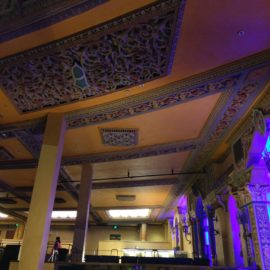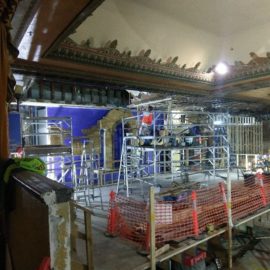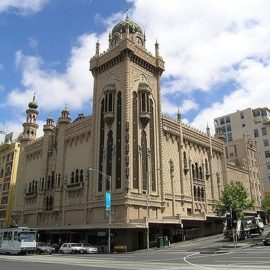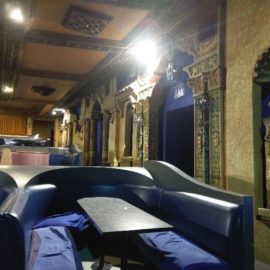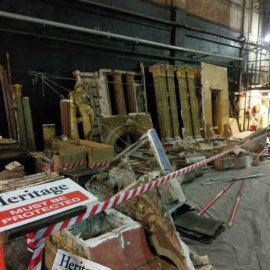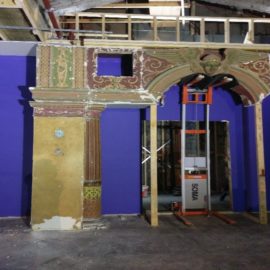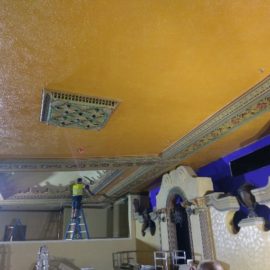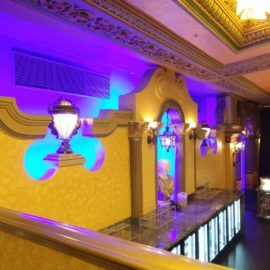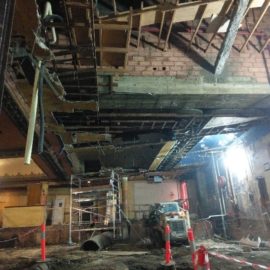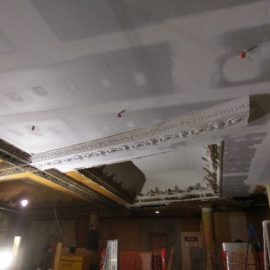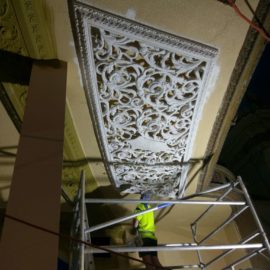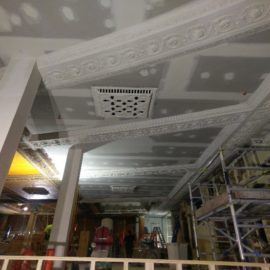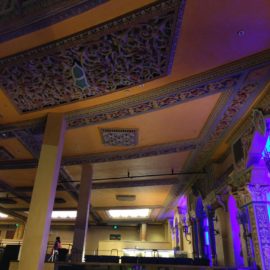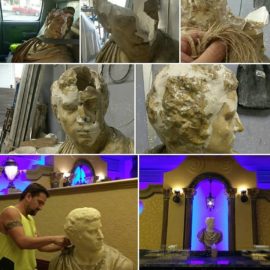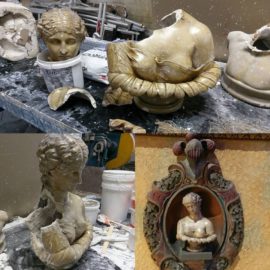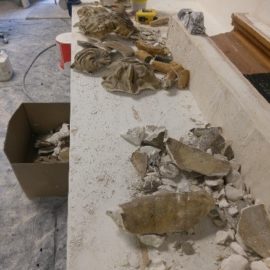
Heritage plaster restoration for Melbourne’s Forum Theatre
The 2017 Melbourne Forum Theatre heritage plaster restoration and redevelopment project was headed by building owners the Marriner Group. The Marriner Group extensively planned and consulted with various specialists with one goal in mind, redeveloping the beloved theatre and modernising its services to re-introduce the theatre as a true multi-purpose venue.
In contrast to the recent demolitions of iconic heritage buildings throughout Australia, the Marriner Group was passionate about restoring the theatre’s heritage. This goal was achieved by restoring the theatre back to its original design and floor plan, as in its 1928 construction, while implementing modern-commercial compliance.
Vision Ornate Plaster’s specialist service was showcased to the client in the previous 2016 renovation of the Melbourne Princess Theatre ground floor and wintergarden ceiling restoration. This project not only displayed our attention to detail and passion, but more importantly developed a great working relationship with the client.
Therefore Vision Ornate Plaster was brought on board for the massive Forum Theatre redevelopment. Our unique scope of works in production, heritage plaster restoration and installation by the one company was a perfect fit for this unique project.
Vision Ornate Plaster, along with the Marriner Group and a vast team including Soma Building (Vic), Threthowan Architecture (Vic), Jackson Interiors (Vic), Mulholland Painting (Vic) and various specialist trades, undertook a major feasibility study of the planned Forum Theatre redevelopment. Countless hours were then spent on design, sequencing and financial planning.
With all this successfully addressed the major redevelopment began.
Major tasks for Vision Ornate Plaster were:
- Retaining and relocating a 30m-long x 4m-high heritage moulding wall, comprising several tons and seven segments of original framing and plaster mouldings.
- Reproducing 300m2 ornamental ceiling, including original ornamental plaster beams, vents and cornice.
- Repairing the theatre’s famous Michelangelo and Grecian-inspired statues.
Additionally, countless heritage plaster restoration works were undertaken throughout the entire building as a result of floor plan renovations and commercial service modernisation, including:
- Reproducing missing and damaged moulds, using specialist moulding techniques such as paint on silicone moulding.
- Customising existing moulds with on-site mould casting and hand carving.
- Developing original moulds to architecturally adapt to modern fittings.
Retaining and relocating a 30m heritage moulding wall
To increase the floor area and bring the theatre’s floor plan closer to the 1928 floor plan, a 30m-long x 4m-high heritage moulding wall needed to be relocated back 10 metres.
The hardwood-framed wall supported large arch arrangements, columns, statues and a giant angel head and wing monument. The wall served as an entrance to the Hosier Lane side bar and kitchen areas that were constructed over the original areas in 1996.
The 1996 bar and kitchen area were demolished and Vision Ornate Plaster conducted an industrial archaeology study. The study determined the materials and techniques used in the original construction of the heritage moulding wall. This helped develop a plan on how to carefully dismantle the wall and eventually re-construct it.
Vision Ornate Plaster then divided up the wall into seven modules, photographing and cataloguing each section in a series of pre-dismantling documents. These proved invaluable for the heritage wall reconstruction and were used by all associated trades.
The seven modules were painstakingly dismantled with framing still intact and another series of demolition documents were catalogued for further reference. With the help of more than 10 tradesmen, the pieces were shifted to storage to wait for re-construction.
With a brand-new floor built and the new location for the wall set out, Vision Ornate Plaster prepared to re-construct the 30 metres and several tons of heritage moulding wall. This included the full clean-up of the framing and plaster, ensuring minimal alterations when re-joining the seven modules and re-strengthening of the load-bearing framing and moulds.
Vision Ornate Plaster used heavy-duty mechanical lifters and manual labour to prop the segments into place safely and accurately. Adding to the challenge and due to the split floor level, re-constructing had to start from the middle segment and work outwards.
No definitive fixing was used until Vision Ornate Plaster and the clients were satisfied with the positioning. Modern-day laser levels were also used to re-ensure accuracy of the works. The segments (approximately 3m x 3m in size) came together so accurately that original paint flakes and cracks lined up perfectly.
The wall was further strengthened using ‘scrimming’ (fibreglass and plaster reinforcement) and all required carpentry. After some settling time all joins, cracks and existing damage was repaired to finish off a seamless relocation.
Specialist painters Mulholland then undertook the colour and texturing of the intricate work. The end result is now a stunning heritage moulding wall, complete with modern iridescent halo lighting. The wall is now the spectacular back drop for the Forum’s famous ‘Brutus Bar’.
Reproduction of 300m² of heritage ornamental ceiling
Relocating the Forum Theatre’s massive heritage wall and demolishing the Hosier Lane side bar exposed approximately 300m² of ceiling that had to be restored and reproduced. This comprised reproducing the original 1928 ornamental plaster ceiling beams (bulkheads), which had to identically match the original beams following the theatre’s seating radius. Additionally, ornamental-laced and fluted vents needed to be re-produced to match the existing layout.
There was a unique element with the samples of the original mouldings in the Forum Theatre.
Although the moulds were in generally good condition, originally they had a coating of plaster and cement aggregate brushed on in 1928. This finish was desired by the original architects to replicate a European ‘scumble’ texture finish.
The big challenge was that Vision Ornate Plaster had to restore the mouldings to match the existing look. If reproduced directly, the scumble finish would be exaggerated with re-installation and finishing. Conversely, if the moulds were stripped back and restored to highly accurate modern reproduction quality, they may have looked artificial or mechanically produced.
The sample pieces were taken from the theatre to the workshop and, through a tedious process of trial and error, Vision Ornate Plaster ascertained the perfect level of restoration required.
We reproduced large silicone moulds of the originals, using a total of almost 100kg of silicone rubber.
Once the moulds were ready, more than 50 casts of these ornamental beams, vents and cornice were produced by hand in Vision Ornate Plaster’s workshop, using more than three tons of casting plaster.
Returning to the theatre, Vision Ornate Plaster’s team of specialists set out and installed the mouldings to match exactly what was originally installed in the 1928 construction. Installation had to be well though-out, as following the existing substrates proved challenging and again, a balance of replication and restoration had to be considered.
Specialist painters Mulholland then set about painting the fresh white casts, matching them perfectly to the original multi-coloured decorations.
The end result is a spectacular series of plaster beams, vents and cornice following the theatre’s curves and decorations.
Repairs to the Melbourne forum statues
Many of the Forum Theatre statues originally installed in 1928 had been damaged over the decades. A mixture of broken busts and full-sized statues presented a unique opportunity to work on some classic Michelangelo and Grecian reproductions.
To ensure the careful preservation of these works of art, the repair of the statues was undertaken in accordance with the Burra Charter. This heritage charter calls for the precise repairs and restoration of the works to strictly include the exact materials and techniques as used in the originals.
In line with the charter, Vision Ornate Plaster acquired the exact materials used in the originals, only Hessian and casting plaster were used and no modern day glue or fixings were used.
The Marriner Group had kept all the broken pieces and fragments. A detailed Heritage and Statue Report was produced by Threthowan Architecture, making the restoration a lot easier.
The damaged statues were taken back to Vision Ornate Plaster’s workshop and forensically put back together. This was a painstaking process as all surfaces had to be prepared and identified for the overall repair. Also with the use of the heritage materials, longer gluing times had to be allowed for, as opposed to modern fast-setting compounds.
The work was repeatedly checked against the Heritage and Statue Report for accuracy and occasional missing pieces meant that some elements had to be freehand sculpted and carved.
The star of the show, Michelangelo’s Brutus, was one of the most badly damaged. After an entire ‘cranial reconstruction’, Brutus is now the proud centrepiece of the new ‘Brutus’ bar in the Forum Theatre – and the exquisite bar is a jewel in the theatre’s redevelopment.
Please contact us for more information about our heritage plaster restoration work.

